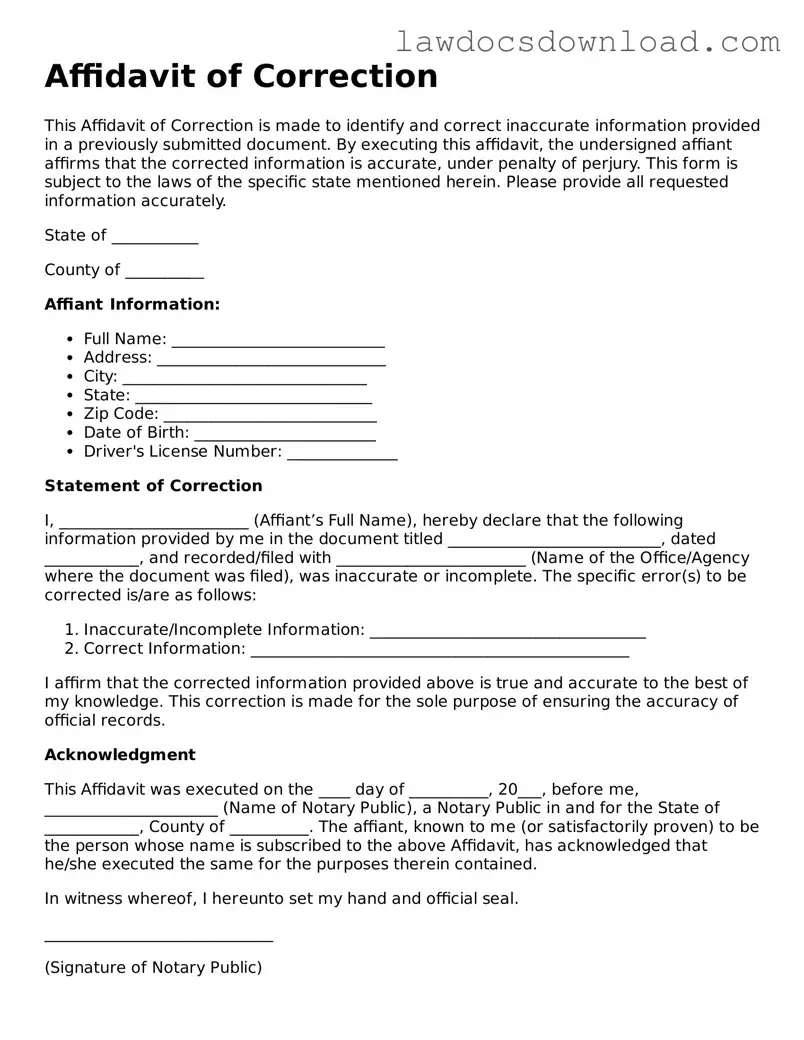An Amendment Form shares a close resemblance with the Affidavit of Correction as they both serve the purpose of making alterations to previously submitted documents or information. The Amendment Form is typically used to correct or update information within legal documents or records, much like the Affidavit of Correction, which is specifically designed to rectify errors in documents like titles, deeds, and records. The main difference lies in the specific context of use, though both aim to ensure the accuracy and up-to-dateness of official records.
Similarly, a Deed of Correction mirrors the function of an Affidavit of Correction, with its primary use in the realm of real estate. This document is employed to correct errors in property deeds, such as misspelled names, incorrect property descriptions, or other inaccuracies. Like an Affidavit of Correction, it legally amends the original deed, ensuring that property records reflect accurate information. Both documents play crucial roles in maintaining the integrity of legal and property documents.
The Errata Sheet, often used in legal and publishing fields, also parallels the Affidavit of Correction. It lists errors and their corrections for a given document, such as a book or legal testimony transcript. While an Errata Sheet is more commonly associated with non-legal texts, it serves a similar corrective purpose, enabling authors or witnesses to pinpoint and rectify inaccuracies post-publication or filing, akin to how an affidavit corrects errors in official documents.
A Supplemental Statement is another document that bears a resemblance to the Affidavit of Correction by providing additional information or clarifications needed to correct or complete a previous statement or filing. It's often used in financial or legal contexts where the initial document lacked comprehensive details. By supplying missing information, the Supplemental Statement, like the Affidavit of Correction, ensures that records are complete and accurate.
Modification Agreements are akin to the Affidavit of Correction in that they both involve the process of officially changing details within agreements or contracts. However, a Modification Agreement is typically used to update terms within contracts, such as loan agreements, reflecting changes in agreement conditions rather than correcting mistakes. Still, the premise of making formal changes to documented agreements unites these two documents.
Correction Instruments in the context of financial instruments or securities operate similarly to Affidavits of Correction. These are used to amend any mistakes made in the issuance or recording of financial documents, ensuring the correct information is reflected in official financial records. The Correction Instrument, like the Affidavit of Correction, plays a vital role in the integrity and accuracy of financial documentation.
A Revised Edition of a document or publication serves a purpose similar to that of an Affidavit of Correction when it comes to addressing errors. Revised Editions are issued to correct mistakes and update information in previously published works, ensuring that readers have access to the most current and accurate information. Although not a legal document, the concept of correcting and updating aligns closely with the essence of what an Affidavit of Correction accomplishes in a legal context.
Finally, a Record Rectification Form within governmental or organizational contexts provides a method for individuals to request corrections to personal records, such as employment, health, or educational records. This form functions similarly to an Affidavit of Correction by facilitating the correction of inaccuracies in official records, ensuring that they reflect the true and intended information. Both documents are vital for maintaining the credibility and accuracy of recorded information.
